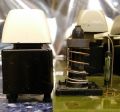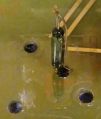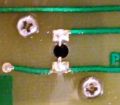Key Tronic magnetic reed
This article is a stub. You can help Deskthority by expanding it.
| This article requires additional photographic illustration — infobox image, and additional disassembly to clarify the construction |
| Manufacturer | Key Tronic |
|---|---|
| Switch type | Linear |
| Sense method | Reed |
History[edit | edit source]
General consensus indicates that Key Tronic Corp. produced reed switch keyboards during the 1970s. Specific dates and catalog information have not been discovered.<ref name="ktc19790" /><ref name="ktchistory" /><ref name="ktcccho" />
Variants[edit | edit source]
Variant 1[edit | edit source]
-
Variant 1 switches
-
Internal mechanism
-
Reed
- The keyswitch housings were produced in several "bank" configurations. The minimum housing configuration, 1, was used for space bars and singleton keys. The maximum, 6, was used for central rows.
- The upper housing contains slider guides, but is otherwise a simple rectangular enclosure.
- The lower housing contains conical plastic projections that stand upright, holding the reed valves and covering them completely.
- The slider is a one piece mechanism containing a circular magnet and spring. The spring compresses the magnet against the top of the slider and provides resistance to counteract fingers and gravity.
- The housing is held together by a screw and nut; a third nut holds the assembled switch to the PCB.
- The reed is soldered directly to the PCB.
Variant 2[edit | edit source]
-
Variant 2 switches
-
Internal mechanism
-
Reed
-
Switch case removed from reed switch
-
Switch case top separated from base
-
Bottom view of case top containing plunger
-
Switch parts
-
Switch parts
-
Reed switch
-
Reed switch
-
Single unit switch PCB retaining screws and reed switch solder points
-
Reed switch, green glass
-
Reed switch, yellow glass
Variant 2 is similar to variant 1. The switches feature a different slider top, cut off reed enclosure tips, and a spring with fewer coils. Those design choices were likely made to decrease material cost and reduce keyswitch travel distance. Additional differences are visible in the gallery.<ref name="ktccustom" />
Feel & Sound[edit | edit source]
Variant 1 is exceptionally linear and fairly smooth. A light "ting" or "ping" can be heard when the switch activates. It is not a light switch. Variant 2 should be equally linear due to its design, though that fact cannot be verified.
Availability[edit | edit source]
The switches are difficult to find. The cause is unknown; factors other than switch rarity, such as false identification, could play a role.
Keyboards[edit | edit source]
- Key Tronic Corp. 65-0201-09
- Custom Key Tronic Corp. Keyboard<ref name="ktccustom" />
- KTC A 24956
- KTC A65-00627-021 PCB-002J
References[edit | edit source]
<references> <ref name="ktc19790">Deskthority — Key Tronic Corp. Serial No.19790</ref> <ref name="ktchistory">Deskthority — Interesting History of Key Tronic</ref> <ref name="ktcccho">Google Books — Line in "Complete Computer Hardware Only"</ref> <ref name="ktccustom">Imgur — Photos of custom Key Tronic keyboard</ref> </references>













